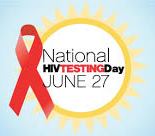 June 27, 2014 marks the nation's 10th annual National HIV Testing Day (NHTD). NHTD was first observed on June 27, 1995 to support and promote the importance of HIV testing.
June 27, 2014 marks the nation's 10th annual National HIV Testing Day (NHTD). NHTD was first observed on June 27, 1995 to support and promote the importance of HIV testing.
In 2014, the campaign's slogan emphasized "Take the Test, Take Control." The Forum was able to post fliers publicizing free HIV testing at the local Walgreens on the University of California Washington Center elevators.

Young people ages 13-24 account for over one fourth of all new HIV infections in the United States, so it is important to target areas with large groups in this age range.
With antiretroviral therapy, people living with HIV (PLWH) can attain life expectancies very similar to the general population and also dramatically decrease their rates of HIV transmission. These are only some of the many reasons why routine HIV testing is so vital to maintaining public health. Early treatment can benefit both the PLWH and the larger community that they are part of.
Since 2006, the Centers for Disease Control and Prevention (CDC) have recommended everyone ages 13 to 64 to get tested for HIV at least once.
Some individuals with specific risk factors are recommended to have more frequent testing. Traditionally, a standard HIV antibody test detects the
presence of antibodies to HIV that typically take 2-8 weeks to develop. This year, the CDC updated their recommendations to better diagnose acute HIV by recommending using a 4th generation HIV test, which detects both HIV antibodies and the p24 antigen. Because p24 can be detected 4-7 days sooner than antibodies, this test can help identify HIV cases earlier.




